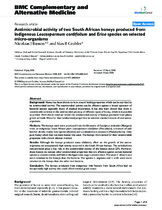| dc.contributor.author | Basson, Nicolaas | |
| dc.contributor.author | Grobler, Sias Renier | |
| dc.date.accessioned | 2013-05-06T11:36:56Z | |
| dc.date.available | 2013-05-06T11:36:56Z | |
| dc.date.issued | 2008 | |
| dc.identifier.citation | Basson, N.J., & Grobler, S.R. (2008). Antimicrobial activity of two South African honeys produced from indigenous Leucospermum cordifolium and Erica species on selected micro-organisms. BMC Complementary and Alternative Medicine, 8(41): 1 – 4 | en_US |
| dc.identifier.uri | http://hdl.handle.net/10566/597 | |
| dc.description.abstract | Background: Honey has been shown to have wound healing properties which can be ascribed to
its antimicrobial activity. The antimicrobial activity can be effective against a broad spectrum of
bacterial species especially those of medical importance. It has also been shown that there is
considerable variation in the antimicrobial potency of different types of honey, which is impossible
to predict. With this in mind we tested the antimicrobial activity of honeys produced from plants
grown in South Africa for their antibacterial properties on selected standard strains of oral microorganisms.
Methods: The honeys used were produced from the blossoms of Eucalyptus cladocalyx (Bluegum)
trees, an indigenous South African plant Leucospermum cordifolium (Pincushion), a mixture of wild
heather shrubs, mainly Erica species (Fynbos) and a Leptospermum scoparium (Manuka) honey. Only
pure honey which had not been heated was used. The honeys were tested for their antimicrobial
properties with a broth dilution method.
Results: Although the honeys produced some inhibitory effect on the growth of the microorganisms,
no exceptionally high activity occurred in the South African honeys. The carbohydrate
concentration plays a key role in the antimicrobial activity of the honeys above 25%. However,
these honeys do contain other antimicrobial properties that are effective against certain bacterial
species at concentrations well below the hypertonic sugar concentration. The yeast C. albicans was
more resistant to the honeys than the bacteria. The species S. anginosus and S. oralis were more
sensitive to the honeys than the other test bacteria.
Conclusion: The honeys produced from indigenous wild flowers from South Africa had no
exceptionally high activity that could afford medical grade status. | en_US |
| dc.language.iso | en | en_US |
| dc.publisher | BioMed Central | en_US |
| dc.rights | This is an Open Access article distributed under the terms of the Creative Commons Attribution License (http://creativecommons.org/licenses/by/2.0), which permits unrestricted use, distribution, and reproduction in any medium, provided the original work is properly cited. | |
| dc.source.uri | http://dx.doi.org/10.1186/1472-6882-8-41 | |
| dc.subject | Antimicrobial | en_US |
| dc.subject | Leucospermum cordifolium | en_US |
| dc.subject | Erica species | en_US |
| dc.title | Antimicrobial activity of two South African honeys produced from indigenous Leucospermum cordifolium and Erica species on selected micro-organisms | en_US |
| dc.type | Article | en_US |
| dc.privacy.showsubmitter | false | |
| dc.status.ispeerreviewed | true | |
| dc.description.accreditation | Web of Science | en_US |

